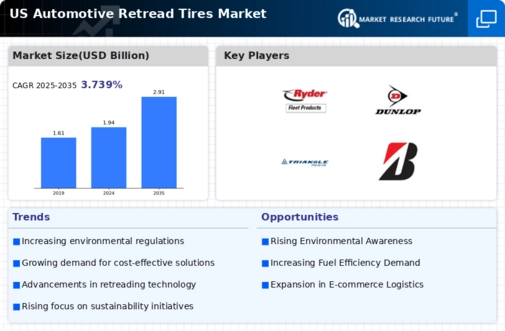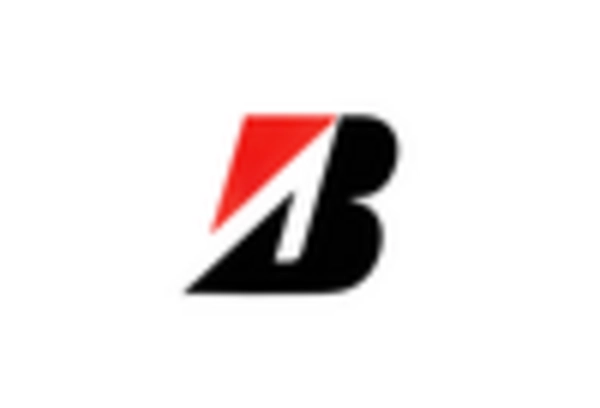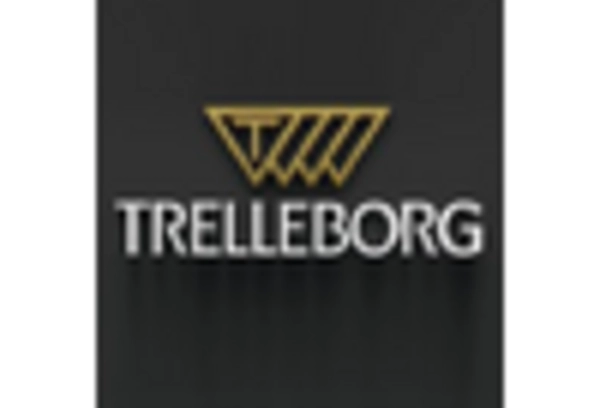Rising Fuel Prices
Rising fuel prices are a significant driver for the automotive retread-tires market, as they compel consumers and businesses to seek cost-effective solutions. With fuel costs fluctuating, the demand for retreaded tires, which offer better fuel efficiency, is likely to increase. Retreaded tires can provide improved rolling resistance, which can lead to better fuel economy, thus appealing to fleet operators looking to minimize operational costs. The automotive retread-tires market is expected to benefit from this trend, as companies aim to reduce their overall fuel expenditures. Additionally, the potential for retreaded tires to extend the life of existing tires further enhances their attractiveness in a market where fuel prices are a critical concern for many.
Environmental Regulations
The automotive retread-tires market is increasingly influenced by stringent environmental regulations aimed at reducing waste and promoting sustainability. In the US, regulations encourage the recycling of materials and the reduction of landfill waste, which aligns with the retreading process that reuses existing tire casings. This regulatory environment not only supports the growth of the automotive retread-tires market but also positions retreading as a more environmentally friendly alternative to new tire production. The retreading process can save approximately 70% of the energy required to manufacture new tires, which is a compelling statistic for environmentally conscious consumers. As regulations continue to evolve, the automotive retread-tires market is likely to see a surge in demand as businesses and consumers seek compliant and sustainable tire solutions.
Cost Efficiency of Retreading
The automotive retread-tires market benefits from the cost efficiency associated with retreading tires. Retreading can reduce the cost of tire replacement by up to 30-50%, making it an attractive option for fleet operators and individual consumers alike. This economic advantage is particularly relevant in the current climate, where rising raw material costs have pressured budgets. As a result, the automotive retread-tires market is experiencing increased demand from businesses seeking to optimize their operational costs. Furthermore, the longevity of retreaded tires, which can last for an additional 50% of their original tread life, enhances their appeal. This cost-saving potential is likely to drive growth in the automotive retread-tires market, as more consumers and businesses recognize the financial benefits of retreading over purchasing new tires.
Technological Innovations in Retreading
Technological innovations in the retreading process are transforming the automotive retread-tires market. Advances in materials and manufacturing techniques have improved the quality and performance of retreaded tires, making them more competitive with new tires. For instance, the introduction of advanced rubber compounds and precision engineering has enhanced the durability and safety of retreaded tires. These innovations not only improve the performance of retreaded tires but also increase consumer confidence in their reliability. As technology continues to evolve, the automotive retread-tires market is likely to see a rise in adoption rates, as both consumers and businesses recognize the benefits of high-quality retreaded products.
Increased Awareness of Retreading Benefits
Increased awareness of the benefits of retreading is driving growth in the automotive retread-tires market. Educational campaigns and advocacy from industry organizations have highlighted the economic and environmental advantages of retreaded tires. As consumers become more informed about the cost savings and sustainability aspects of retreading, demand is expected to rise. The automotive retread-tires market is likely to see a shift in consumer perception, with retreaded tires being viewed as a viable alternative to new tires. This growing awareness is crucial, as it not only influences purchasing decisions but also encourages more businesses to consider retreading as a standard practice, further propelling market growth.

















Leave a Comment